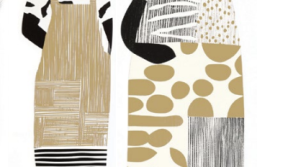Cultural norms, discrimination, and lack of educational opportunities have resulted in a large reserve pool female labor in Bangladesh. Women’s historical exclusion from the wider labor market, combined with the industry’s willingness to exploit the “comparative advantage of women’s disadvantage,”[1] accounts for the fact that female workers constitute an overwhelming 85% of Bangladesh’s 4 million garment workers. Employers favor female workers because they believe they women are more dexterous, docile, and willing to work longer hours for less pay. Earning the minimum wage of $37 USD a month, an amount 3-4 times lower than the estimated living wage[2], Bangladeshi workers are the lowest paid garment laborers in the world. With overtime routinely mandated and often unpaid, hourly earnings average $0.22 an hour[3], much less than in other, non-female dominated Bangladeshi export industries, and considerably less than is earned in non-export industries.[4]
The international demand for cheap labor, along with contracts from low end, fast-fashion brands demanding rapid turnarounds, provides incentives for garment factory owners to cut corners to remain competitive in a global market and to require workers to work long hours for low pay in abusive and hazardous working conditions. Thousands have died in preventable fires and building collapses in the last two decades. In a country with poor infrastructure, an uneducated and impoverished population, Bangladeshi exporters have chosen to maximize returns by keeping labor costs low rather than attempting to increase worker productivity. Within this model, women serve as an unskilled, inexpensive, easily replenishable work force. As uncontracted workers, women lack the protections, benefits, and maternity leave legally required, but poorly enforced, by the state. Workdays average 10-11 hours - sometimes more - and workers report forced overtime and withheld or delayed wages.[5]
While female laborers’ perceived disposability and prevalence in the garment industry has contributed to the poor working conditions faced by garment workers as a whole, female laborers face several gender specific challenges. Gender segregation within the garment industry, with women concentrated in the lowest paying stages of production, contributes to a significant wage gap between men and women’s earnings. While women’s relative lack of educational opportunities accounts for some of this wage disparity, a man with the same experience and educational background can expect to make 41% more than his female counterparts.[6] Women also face sexual harassment within and while traveling to and from factories. Despite making up only 2-3% of the female population in the capital of Dakha, 11% of rape cases involve female garment workers.[7]
Most female workers do not see the garment industry as a humanly sustainable livelihood and few remain within the industry for longer than five years because of occupational hazards, unsustainable working hours, and manager preference for hiring young women and new hires because they will have less employment-related injuries and to save on seniority pay increases. High turnover rates reflect both dismal working conditions and contribute to women’s limited opportunities for advancement due to discrimination and lack of educational opportunities. Rather than seeking to retain laborers, factories simply capitalize on turnover rates by hiring younger workers at lower starting wages. The temporary nature of factory work, combined with brutal union repression, constrains women’s ability to effectively mobilize their collective power to negotiate for better working conditions and higher wages.
While the garment industry has provided an entry point for many women into the labor market, poverty wages and unsafe and exploitative working conditions do not constitute a path to prosperity or the economic security required for true female empowerment. Rather, women’s willingness to endure factory work reflects their relative lack of opportunities in Bangladesh and the indifference of the international community to their right to work with dignity.
The “no job or a sweatshop job” dichotomy perpetuated by Nicholas Kristof and Mathew Yglesias is a false one. A third way exists, which is what garment workers in Bangladesh have been protesting for in the tens of thousands: a job with dignity. There is no question that the multinational corporations whose clothing is sewn in Bangladesh can afford to do better.
[1] Paul-Majumder, Pratima, and Anwara Begum. The Gender Imbalances in the Export Oriented Garment Industry in Bangladesh. Working paper no. 12. The World Bank Development Research Group/ Poverty Reduction and Economic Management Network, June 2000. Abstract. Web. 14 June 2013.
[2] Minimum Wage Implementation in Bangladesh’s Garment Sector. Publication. Alternative Movement for Resources and Freedom (AMRF) Society, 2012. 5. Print
[3] Berik, Günseli, and Yana Van Der Meulen Rodgers. Options for Enforcing Labor Standards: Lessons from Bangladesh and Cambodia. Working paper no. 2008-14. University of Utah, Department of Economics, June 2008. Web.
[4] Carr, Marilyn. Chains of Fortune: Linking Women Producers and Workers with Global Markets. [London]: Commonwealth Secretariat, 2004. 146. Print.
[5]United States. Department of Labor. Office of Child Labor, Forced Labor, and Human Trafficking. Child Labor in the Informal Garment Production in Bangladesh. By ICF International. Bureau of International Labor Affairs, Aug. 2012. Web.
[6] Paul-Majumder, Pratima, and Anwara Begum. The Gender Imbalances in the Export Oriented Garment Industry in Bangladesh. Working paper no. 12. The World Bank Development Research Group/ Poverty Reduction and Economic Management Network, June 2000. 12. Web. 14 June 2013.
[7] Paul-Majumder, Pratima, and Anwara Begum. The Gender Imbalances in the Export Oriented Garment Industry in Bangladesh. Working paper no. 12. The World Bank Development Research Group/ Poverty Reduction and Economic Management Network, June 2000. 18. Web. 14 June 2013.

